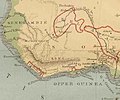History
In 1798, a map resulting from the explorations of the area by Mungo Park [2] showed this west-to-east mountain range for the first time. It was produced by the English cartographer James Rennell, [1] who showed the Niger evaporating inland at Wangara. [2] This range was intended to support his own theory on the course of the Niger River, and eventually led to a major impact on the mapping industry to include the mountains. In 1802, Aaron Arrowsmith released a map that included the Mountains of Kong as a main physical geographic feature of western Africa, which encouraged other publishers to update their maps to match. [3]
The German map-maker Johann Reinecke included the mountains in his map of 1804 as the Gebirge Kong. [1] In 1805, the London engraver John Cary showed them for the first time linking to the Mountains of the Moon. [1]
Various nineteenth-century explorers of West Africa included the range on maps they produced or whose production they directed after exploring the area. These include French explorer René Caillié, who explored the highlands of Guinea at Fouta Djallon, near the source of the Niger; the Cornish explorer Richard Lemon Lander and his younger brother John; and Scottish explorer Hugh Clapperton, who also sought the course of the Niger River in its upper reaches. [1] The historians Thomas Basset and Phillip Porter have identified forty maps, published between 1798 and 1892, showing the mountains. [1] [3]
Despite the failure of other later explorers to locate the range, it continued to appear on maps until late in the nineteenth century. [4]
Cartographers began to stop including the mountains on maps after French explorer Louis Gustave Binger established that the mountains were fictitious, in his 1887–89 expedition to chart the Niger River from its mouth in the Gulf of Guinea and through Côte d'Ivoire. [1]
In 1928, Bartholemew's Oxford Advanced Atlas still contained them in its index locating them at 8° 40' N, 5° 0' W. [1] Even later, they appeared erroneously in Goode's World Atlas of 1995. [5]
This page is based on this
Wikipedia article Text is available under the
CC BY-SA 4.0 license; additional terms may apply.
Images, videos and audio are available under their respective licenses.






